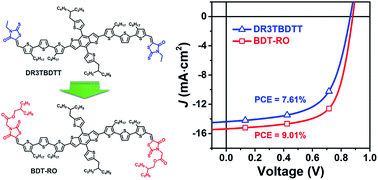Terminal group engineering for small-molecule donors boosts the performance of nonfullerene organic solar cells†
Abstract
Nonfullerene acceptors propelled organic solar cell power conversion efficiencies (PCE) to above 15%. However, most of the reported nonfullerene systems with a PCE > 10% are composed of polymer donors and small-molecule acceptors, while only a few small molecule (SM) donors have been reported. Herein, two new small molecule donors namely BDT-RO and BDT-RN with esterified rhodanine (ER) as the terminal group are reported. The widely used fused-ring acceptor IDIC is chosen to fabricate all-small-molecule solar cells with the new donors. A high PCE of over 9.0% is achieved with BDT-RO, while its isomer BDT-RN shows a PCE close to 8.4%. Comparison with the common small molecule donor DR3TBDTT using the same conditions yielded lower performance (7.6% with IDIC), indicating an 18% enhancement in PCE could be achieved through end group engineering. The efficiency differences are attributed to the different morphology and phase separation resulting from the crystallinity and aggregation ability of the donors. The results demonstrate that ER is a promising building block when designing SM donors for all-small-molecule systems.



 Please wait while we load your content...
Please wait while we load your content...